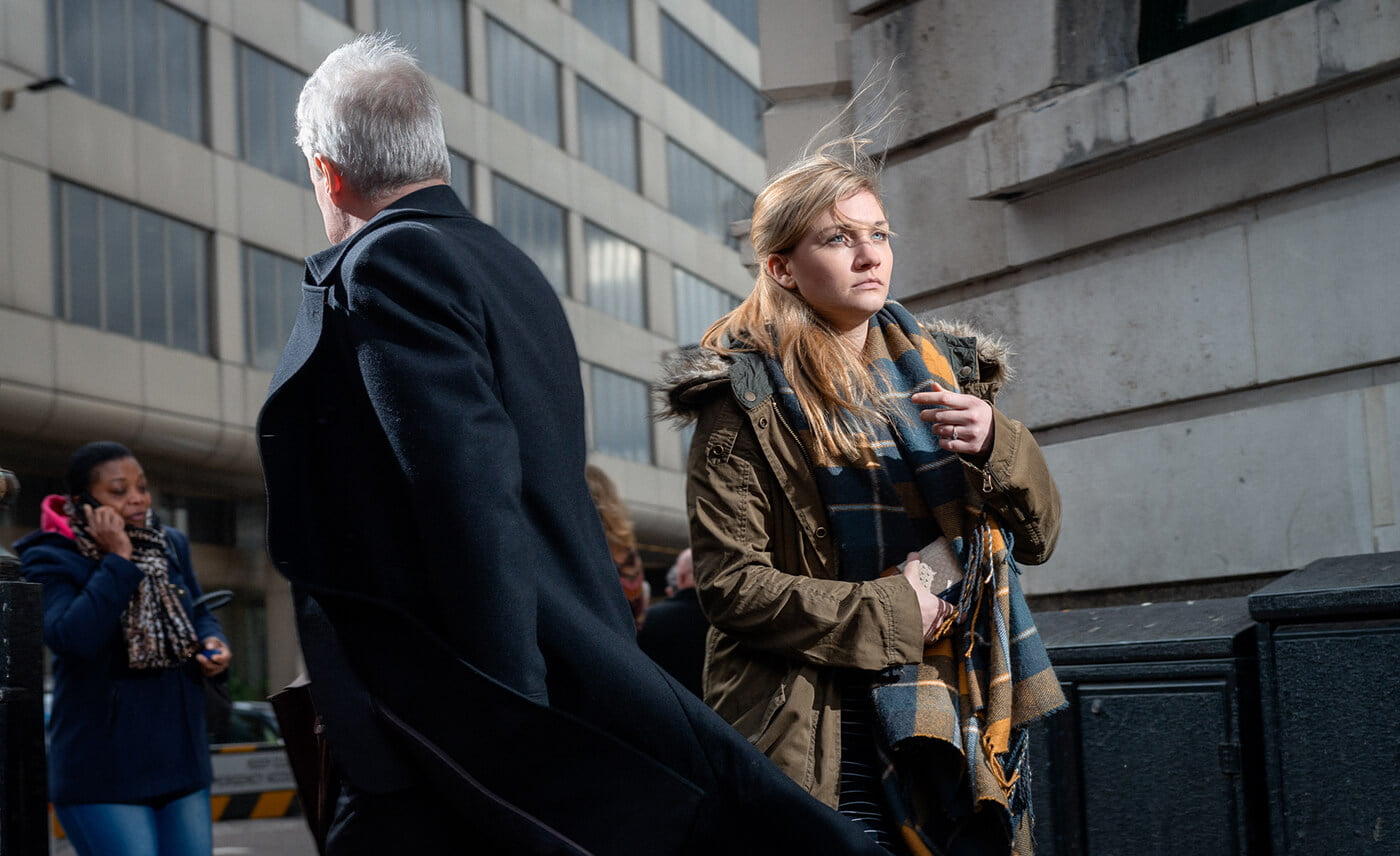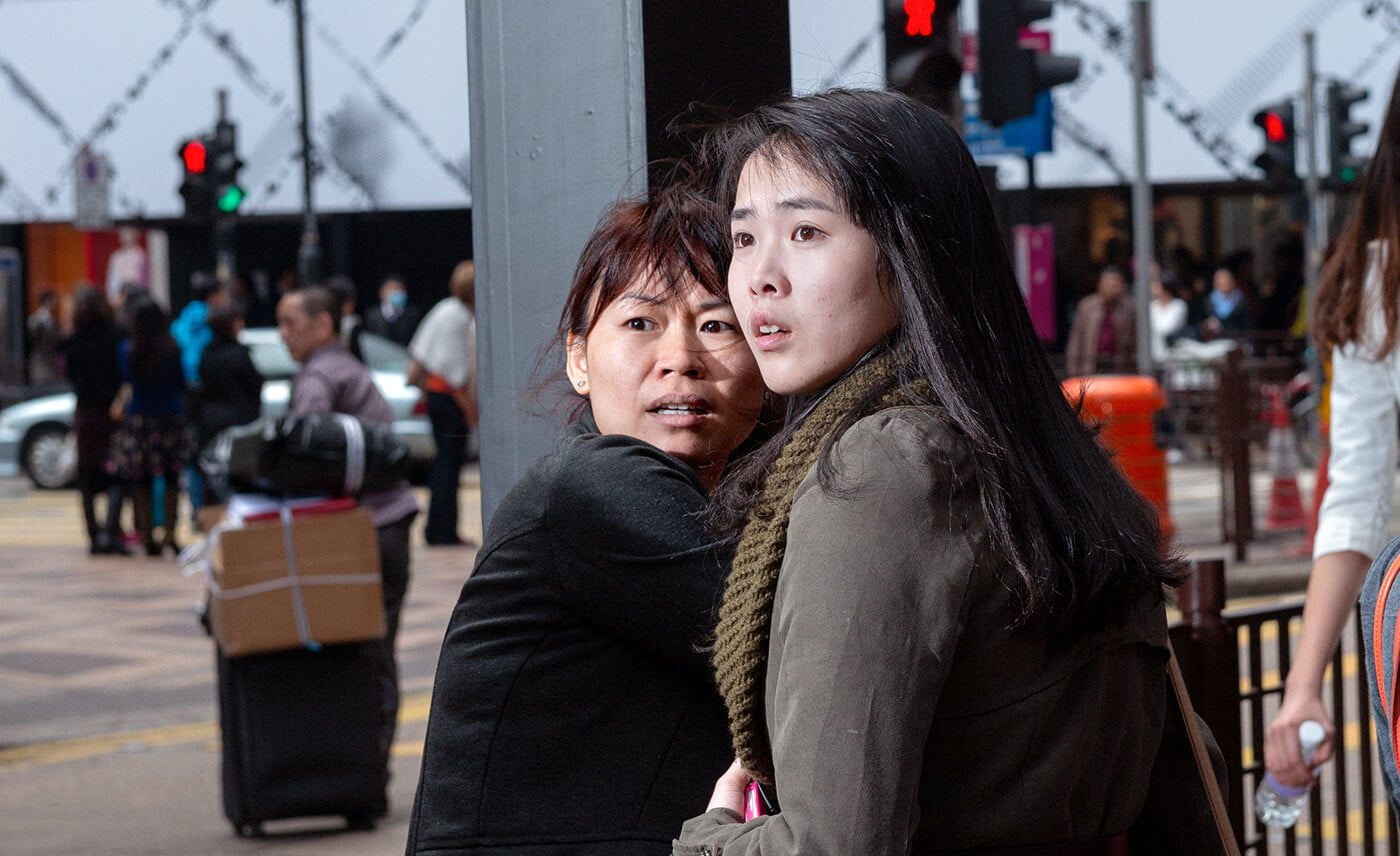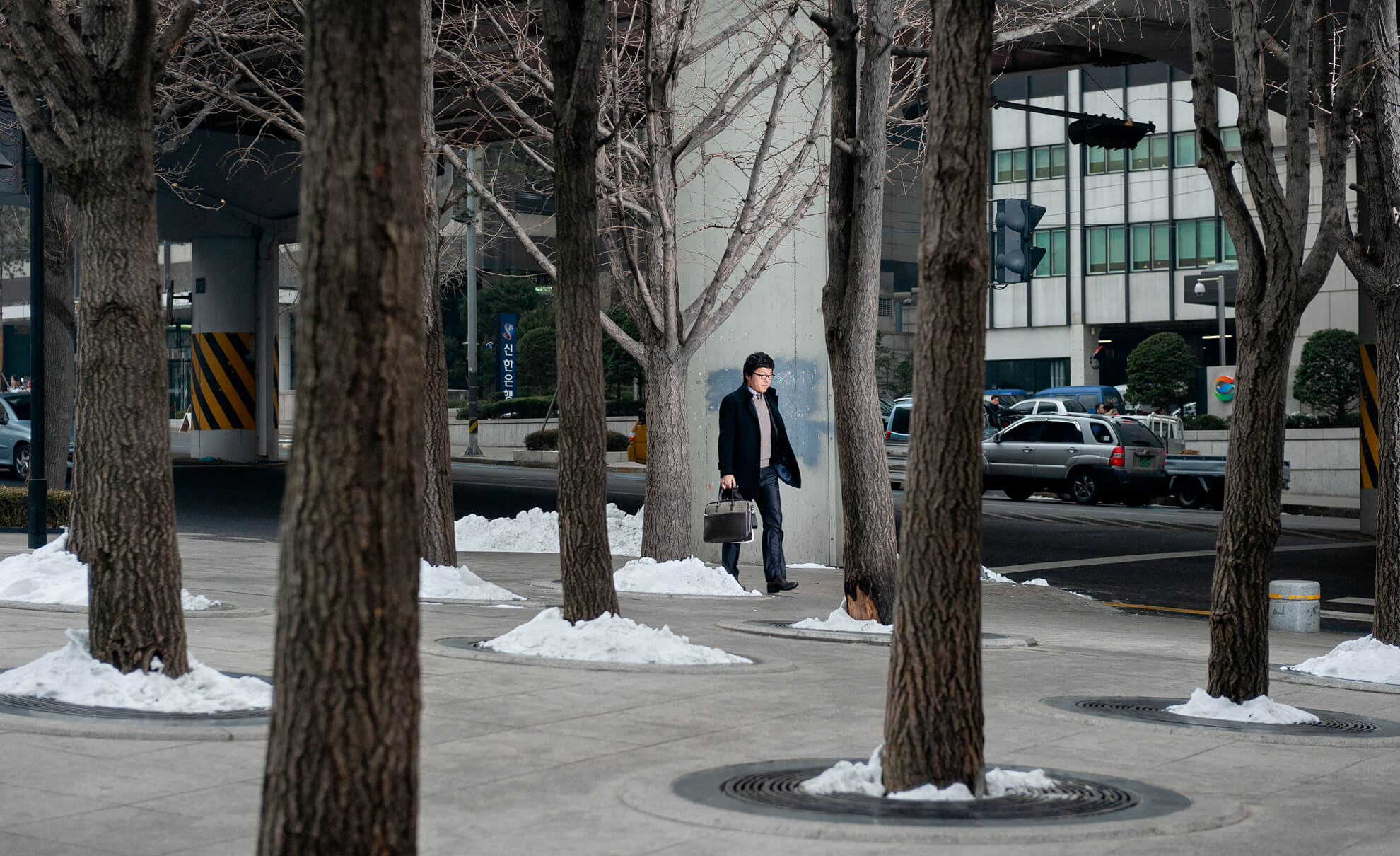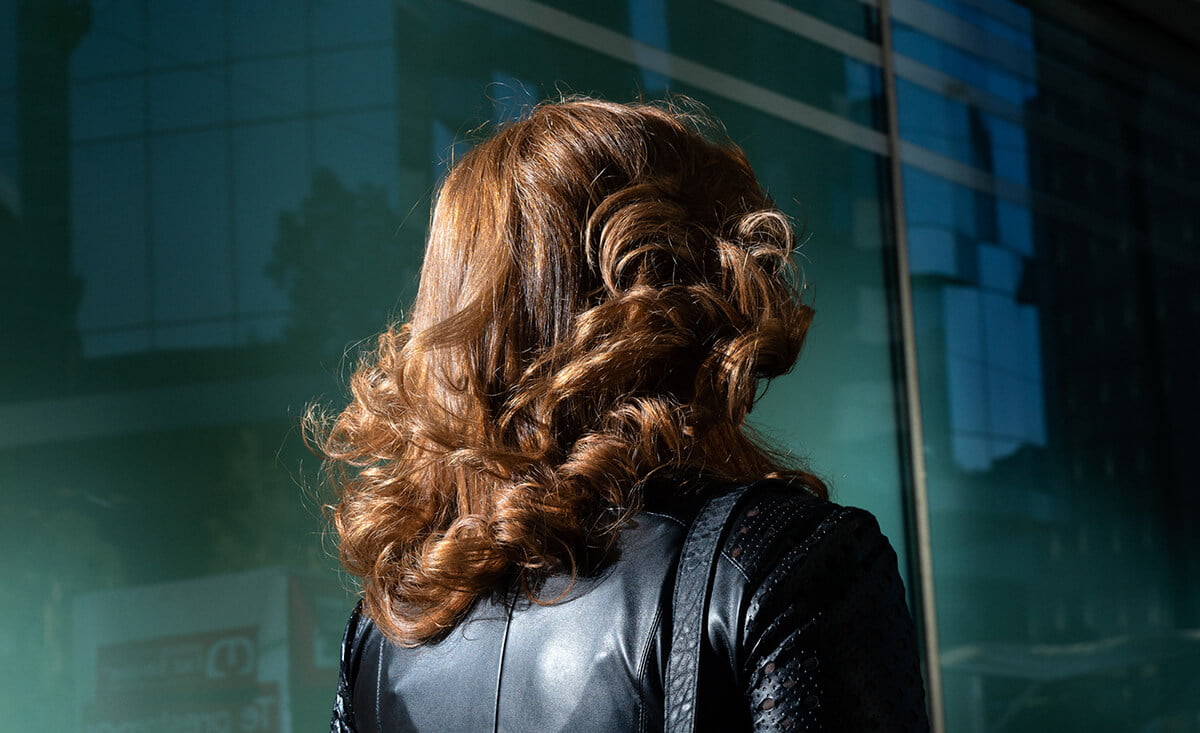INTERVIEW
The Spectacle of the Street
WITH BAS LOSEKOOT
An interview with Bas Losekoot
“This project is about feelings and emotions we all recognize while navigating the city. We like to be a part of a group, and yet, be individual. I believe that in my images you will find people that are “alone together”.”
Dutch photographer Bas Losekoot won our recent competition URBAN LIFE with a stunning freeze-frame street moment, having previously won our competition An Instant back in 2016. The image struck us, both for its arresting subject matter, and for its sublime technical execution, exhibiting a sharpness, or a ‘hyper-reality’ as Bas would put it, unusual for a street image.
Looking through the series from which that image was taken, Out of Place, each frame tells a story of the urban world that now half of the world inhabits – how it confines us, and we retract into our inner-selves in public. How the busiest places can be the loneliest. Bas accentuates these feelings with his considered compositions, where negative space heightens the feelings of isolation and introspection, and where looming shadows are often more prominent than the people. With the recent global pandemic, they are all the more powerful and relevant.
We sat down with Bas to ask him about his ideas behind Out of Place, and his techniques for capturing them. His answers are insightful and thought-provoking.
Hi Bas. Firstly, congratulations on winning our Urban Life competition– winning Life Framer for a second time, five years on from your first win, and with an image from your same mega-project “Out of Place”. Can you tell us a little more about the image and the series it comes from?
In 2011, I started a project towards the beginning of the Urban Millennium; the historic turning point where for the first time more people lived in cities than in rural areas. For me this fact was the starting point for thinking about how this growing population density is influencing the inhabitants of the world’s megacities.
At the moment, we are facing the biggest wave of urbanization in human history. In this project, I try to imagine the consequences for everyday city-life in the future. I consider the city to be the centre of globalised society and with this project, I research how this reflects on its residents. What happens when too many people live on a small surface? How do people react to each other in areas of overpopulation? To me street life is a continuous stream of split-second meetings.
This specific image is shot in Lagos, Nigeria. This city forced me really to re-think my methods. You cannot go out and just shoot wherever you like, so I had to get creative in finding interesting locations to work. Sometimes unexpected elements can get juxtaposed in an extraordinary setting. Lagos Island is a very overwhelming and I fell in love with its energy and chaos immediately.
It is definitely the most difficult city I have ever worked in, yet at the same time, the most interesting. This particular photograph was made at a traffic junction close to the suburb of Ojuelegba. I was drawn to this flyover as the ceiling was completely covered with ashes because of a parked auto bus that was burnt down. I was waiting for a long time for things to happen, and suddenly those two guys walked into the frame. I remember, when I just made the shot, I was not so happy with it, because they were a bit out of focus. Later on, I realised these fast approaching blurred strangers really represent the alienation you can feel in a densely populated megacity.

URBAN LIFE: BAS’ WINNING IMAGE


Our judge, Martin Roemers, described it like a “still from a movie”. Each one is beautifully lit and composed, there’s an immaculate crispness to them that’s rare in candid street photography – they almost feel staged. Can you talk us through your process – what exactly you’re looking for in each of your images, and how you go about capturing them?
As a photographer, I am trained in a classical photo studio. Later on, I got interested in the moving image, and graduated Art school with a mixed-media installation. Later, I studied cinematography at the Dutch Film academy, while I was working as a projectionist in an old cinema in Amsterdam, where I got fascinated with the single film-frame.
On assignment, I worked for many years as a stills-photographer on film sets, where the day consists of a lot of waiting. Therefore, I had the chance to study the decoupage, mise-en-scène and especially: cinematic light. With many gaffers on set, we discussed what might be the “believability of light”.
For more than a decade, I have been interested in cities and got attracted to the images of artists that worked in the public domain. For this project, I decided to take the lights out of the photo studio, starting to imagine the street as one big studio.
Inspired by the double-light situations, created by specular windows from skyscrapers of the financial district in Manhattan; I wanted to create that uncanny reality myself. I started to use flashlights to photograph everyday street-scenes. By creating a mix, between daylight and artificial light, I was able to darken the environment and isolate certain people. First, I tried working with big lights with softboxes and generators with assistants, until I realised that wasn’t working very well. In order to work alone, I chose small compatible speedlights that I attached to traffic lights, trees and whatever I could find.
I began to imagine city dwellers as actors. By approaching the street as a stage, it made me wonder if we might perform our lives. I started to read into performativity theory, for example by the sociologist Erving Goffman – about the presentation of self in everyday life. It seems, we are performing social roles and we wear the appropriate mask for that. While commuting the city, we drop this mask and replace it for another one, the mask of ‘self-protection’. I am interested in this mask, because I believe it provides us a lot of information of the self and the construction of identity.
I use flashlights because it empowers the capacity of photography to really freeze movement. Photography already has the ability to arrest motion, through fast shutter speeds, and the flashlights really emphasize that. Through this technology, like in the stop-motion photography of Edweard Muybridge, I am able to capture something that remains unseen at the normal speed of life. Like film stills, they are a figment of a bigger picture; an extended moment out of an urban continuum. The images suggest off-screen events since they are more about what is outside than inside the frame. They make you wander what just happened or is going to happen next. They are frozen moments that feel unreal – or ‘hyper-real’ as I like to consider them. I intend to slow people down and make them dwell on the meaning of inhabiting the new reality of fast-growing cities.

There’s also an academic starting point to your work which is rare in street photography. In your series statement you talk about ideas of the evolution of man – how survival is no longer about staying alive, but now about staying in our jobs and climbing the social strata. How we no longer run from life-threatening danger but from danger of exclusion, and how the ‘modernisation’ of the world has happened at a pace too fast for us to acclimatise to, creating stress and anxiety.
What got you interested in these ideas? And what made you want to translate them into this project?
The core question when starting this project was; are we creating an ideal society by making these cities grow at such speed and to such sizes? Architect Rem Koolhaas describes the “escape to the future”, and where cities can only exist by the virtue of their own problems. I got interested in how this fast-growing urban density is influencing human behaviour. To understand modern urban life, I started to approach the city as a cage, not an urban jungle but more a human zoo. I would visit its confinements.
Later on, I referred to my work more as a forest. The buildings are the trees; the roads are the rivers. The forest is also a symbol for the overdose of stimuli we have to cope with while manoeuvring in the streets. By instinct, every impulse is processed as a one-second judgement. The forest is dense, we feel at home there, but it is also full of danger, we always have to pay attention. Just like in the natural forest, it is a survival of the fittest.
You also talk about “the anonymity of the man in the crowd” and how feelings of isolation can be more intense when a stranger finds themselves in a crowd. Ironically perhaps, you’re yet another stranger in the crowd, documenting, but not connecting with those you photograph. Or am I wrong, do you interact at all with the people you photograph? Is there a desire to?
In urban life, there is an interesting concept of public “togetherness” at play that Richard Sennett describes, as a contradiction: we dwell with the desire to belong to the group, however, at the same time, we seem to avoid contact with that group. Engagement with strangers rarely happens because of the challenges and insecurities that come with it; we could get hurt or disappointed, or we might get involved in a long conversation, that we don’t have time for. Therefore often, the stranger remains unknown.
This project is about feelings and emotions we all recognize while navigating the city. We like to be a part of a group, and yet, be an individual as well. We like to be together, but not the same. I believe, that in my images you will find people that are: “alone together”.
Next to that, I believe that the overstimulation of modern city life makes us detach from space and reality. In a sense, we all get increasingly alienated from social interaction in the streets. While commuting, we always have used many tools for avoidance practice, like eating, reading or sleeping. Nowadays we can email, text, skype, play games, watch films, shoot photos, edit, publish and send them etc. Through the use of the smartphone, we’ve brought the office into the street. The most performed act is the one of pretending to be busy. We have many screens to hide ourselves with, like sunglasses, earplugs and telephones. Whenever we are in an uncomfortable environment, we grab these devices, dramatically decreasing the chance of interacting with individuals outside of our social group.
I have an intrinsic desire to understand people better. With the use of the camera, I hope to get closer and understand them a bit more. The speed of urban life is so intense that I never have the time to talk to people when they pass by. Next to that, I do not like my presence as a photographer to influence the subject. You can see it in people’s eyes when they are aware being watched. After installing the lights, as soon I look into the viewfinder I become a fly on the wall. Sometimes I even forget that I am there. It is a disembodiment, or like Garry Winogrand has put it: the closest you can get to non-existence. This for me personally results in many accidents in traffic while photographing!
I cannot deny that I reflect the loneliness of photographing alone in the street, on the people I capture. I photograph the isolated, uncanny and even alienated people because I feel amazingly close to them. In fact, I am like them, I mean I can see myself navigating through urban space, stressed by the pressure of everyday life, like that as well. Loneliness in cities is counterintuitive mental disease number one. I never really understood how the walls of our apartments we live in can really make people isolated. There is another cosmos behind this ten centimetres, which we often never get to know.
With this project, I like to plea for a more open and communicative society. The encounter with the stranger might be an interesting opportunity or exciting friendship. To share experiences in real life rather than online, we can transform the street into a more human environment, where people look at each other rather than at their telephones. A small gesture to the stranger can mean a lot to him or her. I believe it is in these small urban encounters, where we are triggered by curiosity and can overcome our fear for the unknown; whether the stranger is the casual passer-by on the street, your neighbour or a refugee.



And it’s fair to say these images – and the idea of the crowd, of personal space, of commuting even – have taken on a whole new in light of the pandemic of the last 12 months. How do you reflect on that?
The subject matter of the project seems more relevant than ever: during a lockdown, cities are not attractive environments anymore. Streets are no longer places of engagement and people seem even more alienated from each other. Passing a stranger in the street has become an awkward choreography. This crisis makes us rethink the city; considering new demographic possibilities.
The questions that were at the core of his research are now very actual: Does large-scale urbanisation and high population density, provide a basis for human well-being? And how do we define personal space, in the new one-and-a-half-meter society?
Great inspiration for the start of my project was the book “Delirious New York” by Rem Koolhaas, in which he announced the rapid growth of cities and the beginning of the “Urban Millennium”. Now more than 40 years later, he predicts an exodus from megacities towards the countryside.
In many cities around the world, life has brought to a halt. Suddenly, the so called “progress” is set to pause-mode. I believe the use of flashlights in combination with fast shutter speeds, really emphasise this frozen moment.
You gained your BA Photography in 2001 and then returned to university in 2014 for your MA Photography. What role has university played in your practice? And what are the most important things it taught you?
My BA in photography was a positive experience, where I graduated with a film that combined media like video, super8, freeze frames and still 35 mm photography. Later I started studying for DOP at the Film academy in Amsterdam, realizing I missed the intimacy of still photography. Coming back to photography, I got hungry for more sociology and urban theory and started the MA Photography and Urban Cultures at Goldsmiths, University of London. There I built a theoretical framework and crystallized my ideas and concepts. My fascination for the correlation of photography and cinema made me study the cinematic affect and experience.
It taught me lots of things that changed my understanding of modern megacities. Studying sociology have been critical to how I observe and make sense of urban spaces. It has definitely enabled me to research human behaviour in the public domain and understand the city as an organism.
For example, Henri Lefebvre’s work on rhythm analysis, with its interrelated method for understanding the rhythms of everyday life. His writing alerted me to the fact that everything is always in motion; the city is an ever-changing container. Lefebvre heightened my awareness of the city’s natural and cultural rhythms, such as the flow of workers moving daily in and out of the city. His writings allowed me to be aware of patterns as they unfold. I can, therefore, by carefully observing movements, gestures and gazes, better anticipate events and pre-visualise the image to come.

You describe this project as a “monumental visual exploration on the effects of the growing population density in the most crowded cities” and you’ve chosen 9 fast-growing megacities to photograph – New York, Sao Paolo, Seoul, Mumbai, Hong Kong, London, Lagos, Istanbul and Mexico City. What have these experiences shown you? What differences have you seen across these disparate cities?
The cities are selected based on two criteria: mobility and density. Mobility concerns the dynamics of pedestrians in the streets. Density relates to the number of people in urban centres during rush hour periods. It was in the streets of downtown Manhattan that I created a methodology for use in other cities. In each of those cities I worked for at least one month – walking the streets every day from sunrise till sunset.
I have seen my project evolving through the years, from a more architecture to more sociological approach. When starting this project, I was interested in the differences of all the people I photographed on the streets. However, the differences I experienced were quite obvious. I wanted the project to go beyond that and emphasize the similarities. Due to globalisation, the centres of megacities, including its citizens, get visually amazingly homogeneous. Around the world, we see generations wearing the same clothing, listening to the same music and watching the same movies. In the end, genetically we belong to the same group of primates – something I find very reassuring. Nowadays I am more interested in the things we have in common.
I like the cities to be some sort of zipper of the world; a meeting place of different cultures and tribes. I consider this diversity to be the spectacle of the street: the theatre of the real life. It is a pressure cooker for human expression and development. To me the high concentration and diversity of strangers represent the fun and excitement of exploring the unknown. I am convinced the street is a place to learn from; it can hold up a mirror to society.
The anonymity of the man in the crowd is an important part of the metropolitan experience. Because we cannot cope with the large amount of people we face in the streets everyday, we unconsciously, fear the stranger. The variety of people with different life-styles we encounter in such close proximity, can be overwhelmingly frightening and stressful. For some people, anonymity can lead to serious forms of loneliness and isolation, however others, experience the feeling of being anonymous in the street, as a relief. I think we all have an ambiguous relationship with the city. The unknown can be both, repulsive and attractive; it can mean a threat or a promise.



Do you have a favourite image so far? What is it about this one?
My favourite image is definitely the image of the lady with red hair, that is on the cover of the book. This was one of the first images that really made me continue the project and motivated me to go out and shoot everyday on the streets. This image really resonates with the little everyday battles and the grind of life. It made me realize that lots of people actually do jobs they don’t like. It really made me think of this speech in the film Fight Club by protagonist Tyler Durden in which he states: “An entire generation pumping gas, waiting tables; slaves with white collars. Advertising has us chasing cars and clothes, working jobs we hate, so we can buy shit we don’t need.”
Do you align yourself with the ‘street photography’ scene? Are there others that you think are pushing the genre in interesting directions?
I love street photography in all its forms. I try to learn from its rich history and find a new angle to it. I admire the black and white masters like Robert Frank, Ray Metzker and Garry Winogrand. As well as the later colour specialists like Alex Webb, Joel Meyerowitz and Saul Leiter. I am also drawn to more conceptual approaches of photographers that use the street more as a space rather than place, like Beat Streuli, Paul Graham and Jeff Wall.
Hindsight can be a wonderful thing. What’s the one piece of advice you wish you’d known when starting your career in photography?
I always considered curiosity to be the motor of my work (and for life in general as well). Photography is an art of observation; it is not so much about what you see, but more about the way you see it. So, to younger photographers I would like to advise: start observing people in the streets, stop walking and stand still for a while, and make images that reflect the way you see the world.

And as a visual, anthropological document of the modern man, is there a finishing point in mind for you? I understand you’ve just released a book?
Yes, after working in in 9 cities I consider the project to be finished and I recently published my first monograph. I have worked extensively with the renowned photobook designer Teun van der Heijden on the book. The construction of the book emphasises the cinematic quality of the photographic series. It is structured with different page formats and positions, that mimics the stratification of life in modern megacities.
All choices in the design process have been made to enhance the cinematographic character of photography. Just like in the cinema, it starts in the dark: the introduction is printed in silver ink on black paper and the afterword, as a return to daylight, on warm white paper. With full bleed photos in an almost wide-screen aspect ratio; a condensed font derived from the credits at the bottom of movie posters; and with a substantial line width, we treated the pages as a film screen.
The book contains 11 sections, of which 6 have smaller inserts. So, in these smaller inserts, photographs are accompanied by little pieces of other images. Actually, these inserts allow the viewer to go literally in-depth and immerse oneself in a new episode of the book. By doing so, the different cities flow from one to the other quite organically, emphasizing the concept of “liminality” and the city as “non-place”.
The uncanny feeling of the photographs is reflected in the sequence of the images. The book really is a walk into the non-descript city of the future, where the viewer is invited to see his fellow city dweller through the eyes of certain protagonists.
The texts are remarkable contributions to the photographic series. The foreword is written by design and architecture critic Hugo Macdonald. He delivered a beautiful essay named “The paradox of Living in the City” in which he eloquently raises the question: What does it mean to be human in the city?
Along the photographic series you will find three mini film scripts written by film producer, scriptwriter and thriller author Kasper van Beek. I kindly invited him to write one page of film script based on a photograph of the project, or a character appearing in that specific photograph. Kasper, specialised in strong plot turns, wrote three intriguing pieces that place you straight into the mind of the protagonists.
As an epilogue, I had an interesting conversation with sociologist, urbanist, photographer and filmmaker Paul Halliday. In which we discussed the main themes of the project relating to sociology, anthropology and environmental psychology, such as: rhythm, proximity and mobilities. As well as feelings that we all recognize when we enter the public domain, such alienation, isolation and loneliness. Furthermore, we touched upon some peculiar concepts as “forensic illumination” and “truth of light” in relation to urban photography and cinema.
Thanks for your time Bas. Is there anything else you’d like to add?
Thank you so much for this great award, it means a lot to me. The book can be ordered on my website or by mailing me directly at [email protected]. Signed copies are ready for shipping.



All images © Bas Losekoot
Follow him on Instagram @geertdetaeye and see more and order the book at www.baslosekoot.com
